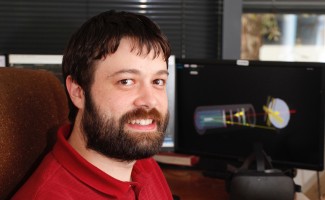Using Computers to Demystify Science and Enable More Efficient Research
Thomas Britton has loved computers since he was first introduced to them in kindergarten. His voluminous resume reflects his passion for developing robust systems and complex and integrated software solutions. Britton is also multilingual, when it comes to computers. He’s conversant in ten different computer programming languages: C, C++, Python, Bash, Shell, HTML, JavaScript, PHP, CSS, MySQL.
While it may be tempting to identify Britton as a computer scientist, he is actually a physicist who is currently working on the Gluonic Excitations Experiment in Jefferson Lab’s Experimental Hall D as a postdoctoral fellow. In fact, his degrees from Coe College are in physics and mathematics; computer science was just his minor.
It is not until one reviews his dissertation from the Syracuse University physics Ph.D. program that it is possible to see hints of his computer science interest; his dissertation was on the Amplitude Analysis of B→J/ψφK (the analysis is where the computer science comes in).
Computers Leading to Faster, More Efficient Scientific Analysis
According to Britton, technology is making it possible for physicists to more efficiently analyze mind-boggling amounts of data. “People are notoriously bad at looking at reams of numbers in an efficient way,” he said. “With the GlueX experiment, we take about one gigabyte of data every two seconds. We really have to rely on more automated systems.”
For GlueX, Britton created an automated system called MCWrapper, which he describes as the “definitive framework for GlueX Monte Carlo simulations.” Physicists use Monte Carlo simulations to make predictions. Monte Carlo may be used to predict what particles will be produced in an experiment or may be used to model how a real detector system functions in different scenarios.
Britton’s MCWrapper system allows researchers to carry out Monte Carlo simulations on any number of different computer systems without the need to customize the configuration for each different system. It’s a kind of plug-and-play Monte Carlo simulator that is pre-configured for all things GlueX. In short, Britton’s technology essentially manages, runs and tracks the production of simulations for the entire experiment.
To make it easier, he created an automated system that takes requests from an online application and handles the processing (mainly on the Open Science Grid). This enables researchers to better utilize available computation resources with ease.
In fact, it was the GlueX experiment that brought Britton to the lab. As he was wrapping up his Ph.D. program, Britton was looking for positions that would enable him to be integral to an experiment’s success by getting involved during the nascent stages and helping to develop technologies specific to the experiment. “I wanted to glom onto projects and have a material impact,” he says. “I felt that because GlueX was on the ground floor, some of my skills could increase efficiency and make scientists’ lives easier.”
Sharing Systems in Pursuit of Science
Part of Britton’s motivation for developing technology solutions is that he values the contribution he can make to a team. “My driving force is building the tools and systems that not only make my research easier to do, but that also help others,” he said.
As he develops his interfaces, he keeps his users’ experiences in mind. Most of Britton’s users are other physicists, he says.
“A lot of my projects come about because I think, ‘Boy, this could be done a lot better if we had these technologies,’” he explains. “I can produce a product that’s better than the predecessor because it’s built on something newer and it solves a wider array of problems. And instead of building something to get just my project done, I can build something for everybody and make a system that’s easier for everyone.”
Britton is also motivated by his love of teaching and sharing his passion for physics. For example, he explains that the learning curve for a new graduate student to understand some technical concepts can take a year or more to overcome. Yet, when they use one of Britton’s tools, “They can get going sooner, because there’s a nice interface to things, turning that trek through the jungle more like a drive down a dirt road.”
It’s not just scientists who benefit from Britton’s tools; Britton designed a user experience for the lab’s most recent biennial open house, which welcomed 6,000 visitors who were interested in learning more about the groundbreaking research happening inside. During Britton’s demonstration, guests donned virtual reality goggles and were taken on a ride aboard a rendition of a subatomic particle as it traveled through the detectors in Hall D. Britton volunteered at the event to ensure that the technology ran smoothly throughout the day.
Technology Requests on Sticky Notes
He keeps himself busy with developing applications and technologies as well as his own research; with all the feature requests his fellow researchers have made, he still jokes that he should invite his colleagues to leave sticky notes on his door with requests so that when he feels like taking on a new project, he can simply go to his door and pick one.
Regardless of whether his project is for his personal research or for his team, he has one guiding principal: “Everything I’ve done is towards producing better, more accurate physics.”
Outside of work, he spends time with his young son, Declan. In fact, the story of his family coincides with his time with GlueX.
“I interviewed for the position 8 a.m. on the morning after getting home from the hospital with Declan. We moved to Newport News when he was six weeks old, and he attended the first collaboration meeting in a baby carrier. The last one he was at he was running around.”
When he finds the time, he also enjoys playing games, both video and board; his son now joins in by helping roll dice.
By Carrie Rogers









































